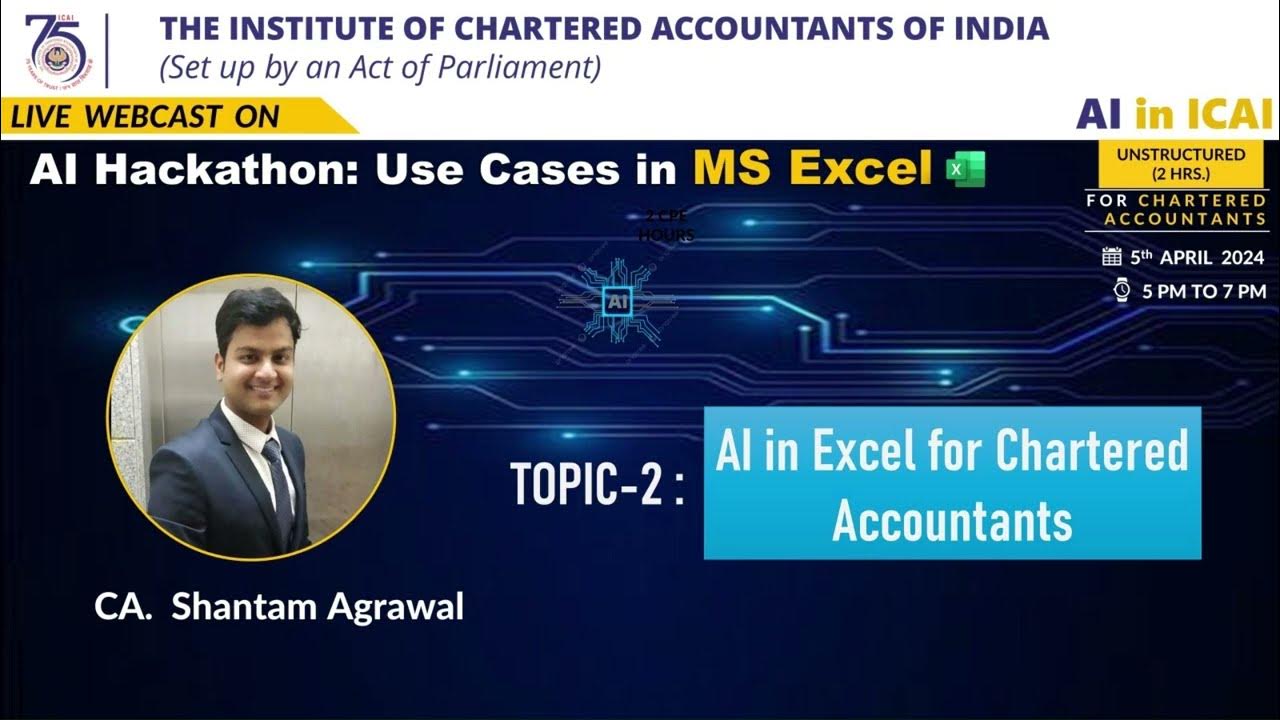Hackathon 1: Series 1 - Use Case 3 | AI in Excel for Bank Audit | CA Premnath Degala
Summary
TLDRThis video demonstrates how AI, specifically ChatGPT, can assist auditors in performing financial analysis and modeling tasks efficiently. The speaker walks through a scenario where they use AI to automate the calculation of loan terms and identify non-performing assets (NPAs) based on financial data such as loan amounts, interest rates, and EMI. By leveraging AI to process large amounts of data quickly, auditors can improve accuracy and save time in their work. The video highlights the importance of prompt creation in AI automation, emphasizing its potential for continuous monitoring in internal audits.
Takeaways
- 😀 AI can automate complex financial tasks like calculating loan terms and NPA status, saving auditors time and effort.
- 😀 The process of auditing loan data involves calculating missing loan terms based on existing information such as loan amount, EMI, and interest rate.
- 😀 By using ChatGPT, auditors can generate downloadable Excel files with calculated terms, reducing the need for manual calculations.
- 😀 The formula used for calculating the loan term is based on Excel's NP function, which simplifies the process for auditors without requiring deep technical knowledge of financial modeling.
- 😀 Once the loan term is calculated, auditors can proceed with further analysis like checking NPA (Non-Performing Asset) status for each loan.
- 😀 AI can also be programmed to flag loans as NPA if certain conditions are met (e.g., if the loan is overdue by more than three days).
- 😀 The use of AI in auditing can greatly enhance decision-making by providing quick, accurate results that auditors can rely on.
- 😀 By leveraging AI, auditors can avoid getting bogged down in repetitive tasks and focus on more strategic activities like interpreting data and making decisions.
- 😀 The ability to process large datasets quickly is a key benefit of using AI in auditing, enabling auditors to scale their efforts to thousands of rows of data.
- 😀 The use of AI in audits demonstrates its potential for continuous monitoring and control, helping businesses to stay compliant and make proactive decisions.
Q & A
What is the main purpose of using ChatGPT in the auditing process demonstrated in the script?
-The main purpose is to automate the calculation of missing loan terms based on data such as loan amount, interest rate, and EMI, and to generate insights such as identifying non-performing assets (NPAs) in financial data.
Why does the user need to calculate the loan term using AI, as described in the script?
-The loan term is not typically provided in the MIS (Management Information System) statement, so the user needs to calculate it based on other available data such as loan amount, interest rate, and EMI, which requires complex financial modeling formulas.
How does the AI calculate the loan term based on the provided data?
-The AI uses the 'NPER' formula (likely referring to 'Number of Periods' in Excel) to compute the loan term based on input data like loan amount, interest rate, and EMI.
What is the role of the AI in managing large datasets in the audit process?
-The AI can process large datasets efficiently, automatically calculating missing data like loan terms and NPAs, which would be time-consuming and error-prone if done manually.
What happens after the AI generates the loan term in the Excel file?
-Once the loan term is calculated, it is added as a new column in the Excel file, allowing further analysis and comparison with documented EMI rates or other relevant data.
How does the AI assist in identifying non-performing assets (NPAs) in the script?
-The AI compares the calculated loan terms to documented dates and uses predefined rules (such as the difference being greater than three) to determine whether a loan is performing or non-performing (NPA).
What is the significance of the prompt used to interact with ChatGPT in this process?
-The prompt is crucial because it defines the specific task the AI needs to perform. A well-crafted prompt ensures that the AI accurately processes the data and provides the desired outputs, such as calculating loan terms and flagging NPAs.
What kind of financial calculations and operations does the AI handle in this scenario?
-The AI handles arithmetic and logical operations such as calculating loan terms using the NPER function, comparing loan terms to dates, and classifying loans as performing or non-performing based on specific criteria.
What potential benefit does AI offer in financial auditing, according to the script?
-AI enhances efficiency by automating repetitive tasks like data entry, calculation, and analysis, reducing the time, effort, and potential errors associated with manual auditing processes.
How can the process demonstrated in the script be scaled to handle larger datasets?
-The process can be easily scaled by applying the same code or prompt to datasets with thousands of rows, allowing auditors to analyze large volumes of data without the need for manual intervention.
Outlines

This section is available to paid users only. Please upgrade to access this part.
Upgrade NowMindmap

This section is available to paid users only. Please upgrade to access this part.
Upgrade NowKeywords

This section is available to paid users only. Please upgrade to access this part.
Upgrade NowHighlights

This section is available to paid users only. Please upgrade to access this part.
Upgrade NowTranscripts

This section is available to paid users only. Please upgrade to access this part.
Upgrade NowBrowse More Related Video

AI Hackathon S3 Ep-8: UC 10 – AI in Excel - AI powered presentation – CA Vidyawati Nirbhay Wange

Manfaat dan Risiko AI (Artificial Intelligence) dalam Bidang Pendidikan

Hackathon 1: Series 1 - Use Case 2 | AI in Excel for Chartered Accountants | CA Shantam Agrawal

Cómo usar ChatGPT para ESTUDIAR

Automate ANY task using ChatGPT! (with GPT actions feature)

7 Best AI Tools You NEED to Try in 2025 (Free & Powerful!) 💡
5.0 / 5 (0 votes)